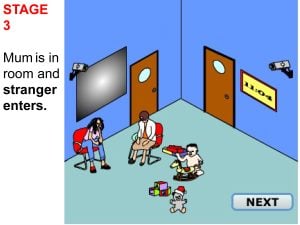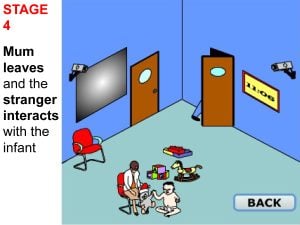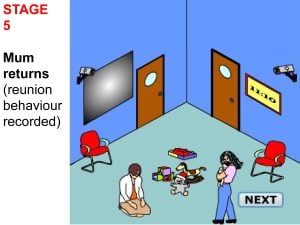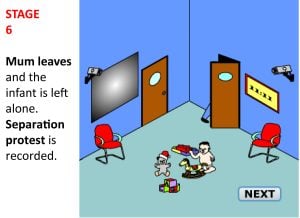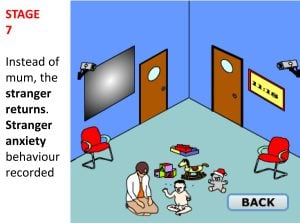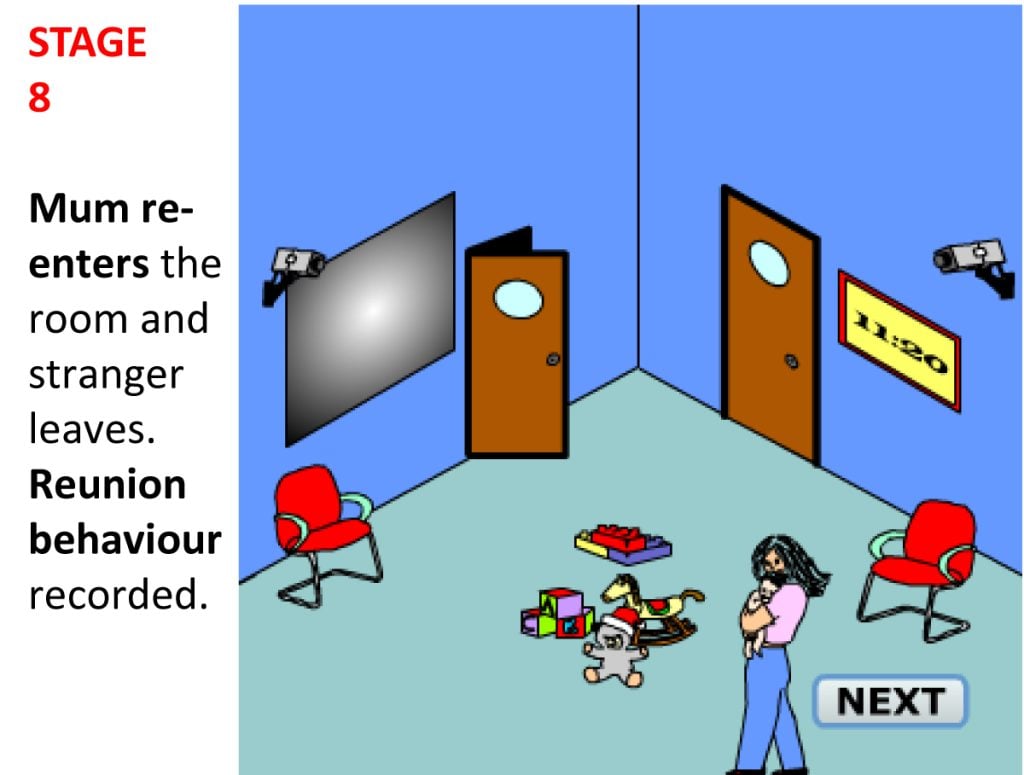On This Page:
The strange situation is a standardized procedure devised by Mary Ainsworth in the 1970s to observe attachment security in children within the context of caregiver relationships. It applies to infants between the age of nine and 18 months.
The procedure involves a series of eight episodes lasting approximately 3 minutes each, whereby a mother, child, and stranger are introduced, separated, and reunited.
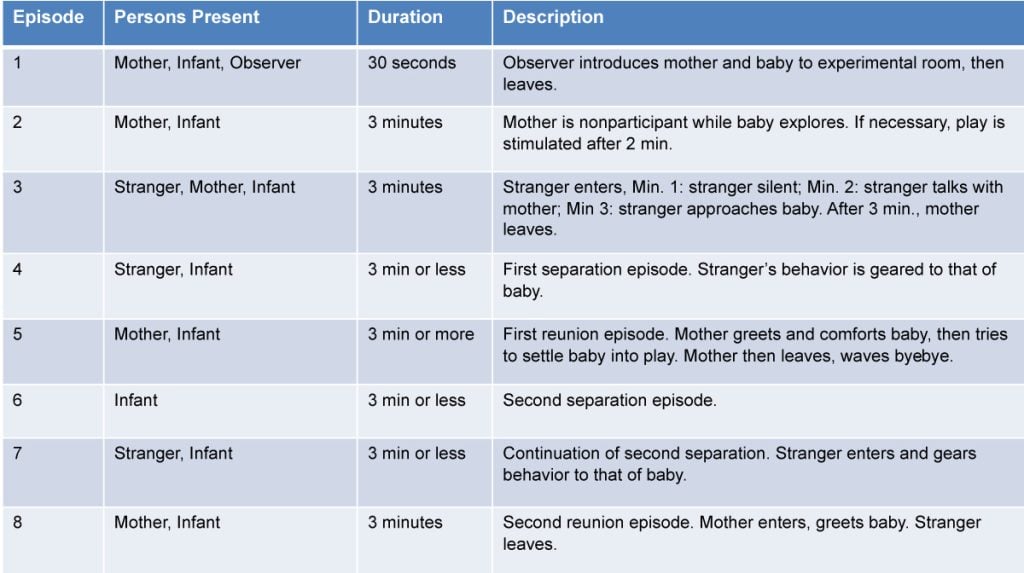
Background
John Bowlby (1969) believed that attachment was an all-or-nothing process. However, research has shown that there are individual differences in attachment quality. Indeed, one of the primary paradigms in attachment theory is the security of an individual’s attachment (Ainsworth & Bell, 1970).
Much research in psychology has focused on how forms of attachment differ among infants. For example, Schaffer and Emerson (1964) discovered what appeared to be innate differences in sociability in babies; some babies preferred cuddling more than others, from very early on, before much interaction had occurred to cause such differences.
It’s easy to know when you are attached to someone because you know how you feel when you are apart from that person, and, being an adult, you can put your feelings into words and describe how it feels.
However, most attachment research involves infants and young children, so psychologists have to devise subtle ways of researching attachment styles, usually involving the observational method.
Psychologist Mary Ainsworth devised an assessment technique called the Strange Situation Classification (SSC) to investigate how attachments might vary between children.
The Strange Situation was devised by Ainsworth and Wittig (1969) and was based on Ainsworth’s previous Uganda (1967) and later Baltimore studies (Ainsworth et al., 1971, 1978).
Mary Ainsworth’s (1971, 1978) observational study of individual differences in attachment is described below.
Strange Situation Procedure
The security of attachment in one- to two-year-olds was investigated using the strange situation paradigm in order to determine the nature of attachment behaviors and styles of attachment.
Ainsworth and Bell (1971) conducted a controlled observation recording the reactions of a child and mother (caregiver), who were introduced to a strange room with toys. About 100 middle-class American infants and their mothers participated in the strange situation.
The strange situation procedure was designed to be novel enough to elicit exploratory behavior and yet not so strange that it would evoke fear and heighten attachment behavior at the outset.
The room was set up with a clear 9 x 9-foot floor space divided into 16 squares for recording location and movement. One end housed a chair laden with toys, while the other had chairs for the mother and a stranger. The baby was placed centrally, free to move around. The mother and stranger were pre-instructed on their roles.
The child is observed playing for 20 minutes while caregivers and strangers enter and leave the room, recreating the flow of the familiar and unfamiliar presence in most children’s lives.
Ainsworth & Bell observed from the other side of a one-way mirror, so the children did not know they were being observed.
The infant’s behavior was observed during eight pre-determined ‘episodes’ of approximately 3 minutes each.
- Mother, baby, and experimenter: The mother, accompanied by an observer, carried the baby into the room, and then the observer left. This episode lasts less than one minute.
- Mother and baby alone: The mother places the baby in a designated area, then sits quietly, only interacting if the baby initiates. This episode lasts for three minutes.
- A stranger joins the mother and infant: A stranger enters the room, sitting silently for a minute, then conversing with the mother for another minute before gradually approaching the baby with a toy. After the third minute, the mother discreetly exits the room.
- Mother leaves baby and stranger alone: If the baby was contentedly playing, the stranger didn’t intervene. If the baby was inactive, the stranger attempted to engage him with the toys.
If the baby was upset, the stranger sought to distract or soothe him. If comfort couldn’t be provided, the episode was cut short; otherwise, it continued for three minutes.
- Mother returns, and the stranger leaves: The mother enters and momentarily pauses at the doorway, allowing the baby to react to her presence spontaneously. The stranger discreetly exited.
The subsequent actions of the mother were not pre-determined, except for instructions that once the baby resumed playing with toys, she would leave again, pausing to say “bye-bye.” The duration of this episode wasn’t fixed.
- Mother leaves; infant left completely alone: The baby was left by themself for three minutes unless their distress level necessitated shortening this time frame.
- Stranger returns: The stranger returned, acting as in the fourth episode for three minutes unless the baby’s distress led to a premature ending. Ainsworth & Wittig had originally designed a different approach for the seventh episode, which was tested on the initial 14 participants (infants) but resembled the more straightforward method reported here and used for the remaining participants.
- Mother returns, and the stranger leaves: The mother comes back, the stranger exits, and once the mother-child reunion is noted, the scenario is concluded.
Scoring
Observers noted the child’s willingness to explore, separation anxiety, stranger anxiety, and reunion behavior.
Two observers narrated continuous accounts into a two-channel tape recorder that also captured a timer’s click every 15 seconds.
This is the standard procedure now, although, for the initial 14 participants, only one observer narrated as the other took notes due to the lack of a two-channel recorder.
For the latter 33 participants, Bell was the sole observer. The observations were later transcribed, consolidated, and coded.
These four classes of behavior were scored for interaction with the mother in episodes 2, 3, 5, and 8, and for interaction with the stranger in episodes 3, 4, and 7.
- Proximity and contact seeking: Behaviors involve active efforts such as purposeful approaching, climbing, gesturing (like reaching or leaning), partial approaches, and directed cries.
The criteria include the child’s initiative, persistence, and effectiveness in gaining (or regaining) contact or proximity. The score reflects the intensity and nature of the child’s efforts across different episodes.
- Contact maintaining: Behaviors relevant after the baby has made physical contact, either self-initiated or otherwise.
They encompass clinging, embracing, resisting release through intensified clinging or turning back and reaching if contact is lost, and vocal protestations.
- Avoidance of proximity and contact: Interaction-avoiding behaviors apply in situations that typically incite approach or interaction, such as an adult entering or trying to attract the baby’s attention.
The behaviors indicative of avoidance include increasing distance, turning away, averting gaze, hiding the face, or ignoring the person, especially when the person is attempting to engage the child’s attention.
Unlike the resistance variable, which is often associated with anger, avoidance may have a neutral tone or reflect apprehension.
It may be seen as a defensive behavior that conceals feelings, possibly including resentment. The coding for this variable distinguishes between the child’s interactions with the mother and a stranger.
- Resistance to contact and comfort: Assesses the child’s resistant behavior towards someone who attempts to interact or come into proximity.
Contact- and interaction-resisting behaviors include angry, conflicting attempts to repel the adult, wriggling to get down if picked up, or rejecting toys used by the adult to interact. Other indications could be angry screams, thrashing about, pouting, irritable fussing, or showing petulance.
These resistant behaviors may alternate with efforts to maintain contact with the person being rejected.
- Search behavior: During episodes 4, 6, and 7, search behaviors were recorded. These included following the mother to the door, attempting to open it, banging on it, keeping the focus on the door or glancing towards it, approaching the mother’s empty chair, or observing it.
These behaviors indicated the infant’s active search or orientation towards the last seen location of the absent mother (usually the door) or a place associated with her in the unfamiliar setting (her chair).
Strange Situation classifications (i.e., attachment styles) are based primarily on four interaction behaviors directed toward the mother in the two reunion episodes (Ep. 5 & Ep. 8).
The observers noted the behavior displayed during 15-second intervals and scored the behavior for intensity on a scale of 1 to 7.
In scoring these five behavior classes, the score was influenced by the following features: the strength of the behavior, its frequency, duration, latency, and the type of behavior itself – with active behavior being considered stronger than signaling.
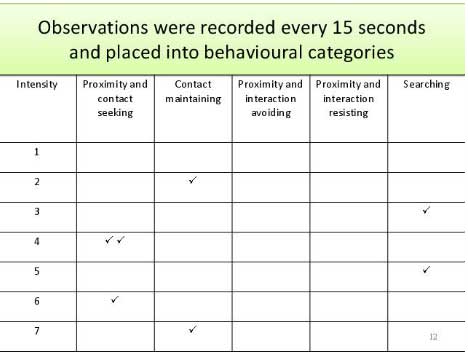
Behavioral categories allow the researcher to focus on the behaviors to observe clearly. For example, smiling, crying, or the baby moving towards or away from the mother.
This allows the observers to tally observations into pre-arranged groupings. It also makes the observations replicable, so the results have greater reliability.
Other behaviors observed included:
- Exploratory behaviors
e.g., moving around the room, playing with toys, looking around the room. - Search behaviors
e.g., following mother to the door, banging on the door, orienting to the door, looking at the door, going to mother’s empty chair, looking at mother’s empty chair. - Affect Displays negative
e.g., crying, smiling.
Observation reliability was assessed by independent codings of the narrated reports by the two authors in four dual-observed cases. Correlation coefficients of 0.99 for each locomotor, manipulatory, and visual exploration, and 0.98 for crying, were achieved.
Results [Attachment Styles]
Ainsworth (1970) identified three main attachment styles, secure (type B), insecure avoidant (type A), and insecure ambivalent/resistant (type C). She concluded that these attachment styles resulted from early interactions with the mother.
A fourth attachment style, known as disorganized, was later identified (Main, & Solomon, 1990).
| Secure | Resistant | Avoidant | |
|---|---|---|---|
| Separation Anxiety | Distressed when mother leaves | Intense distress when the mother leaves | No sign of distress when the the mother leaves |
| Stranger Anxiety | Avoidant of stranger when alone, but friendly when the mother is present | The infant avoids the stranger – shows fear of the stranger | The infant is okay with the stranger and plays normally when the stranger is present |
| Reunion behavior | Positive and happy when mother returns | The infant approaches the mother, but resists contact, may even push her away | The Infant shows little interest when the mother returns |
| Other | Uses the mother as a safe base to explore their environment | The infant cries more and explores less than the other two types | The mother and stranger are able to comfort the infant equally well |
| % of infants | 70% | 15% | 15% |
B: Secure Attachment
Securely attached children comprised most of the sample in Ainsworth’s (1971, 1978) studies.
Infants with this type of attachment explore their environment (explorative behavior) and are moderately distressed when their mother leaves the room (separation anxiety).
They also show moderate stranger anxiety and some distress when they are approached by a stranger. They seek contact with their mother when she returns.
Such children feel confident that the attachment figure will be available to meet their needs. They use the attachment figure as a safe base to explore the environment and seek the attachment figure in times of distress (Main, & Cassidy, 1988).
Securely attached infants are easily soothed by the attachment figure when upset. Infants develop a secure attachment when the caregiver is sensitive to their signals, and responds appropriately to their needs.
According to Bowlby (1980), an individual who has experienced a secure attachment “is likely to possess a representational model of attachment figures(s) as being available, responsive, and helpful” (Bowlby, 1980, p. 242).
In the context of the Strange Situation, a child displaying secure attachment exhibits the following behaviors:
-
Desire for Proximity and Contact: The baby actively seeks proximity and contact with the mother, especially during reunion episodes. This desire reflects a strong emotional connection and trust in the mother as a source of comfort and safety.
-
Maintenance of Contact: Once in contact with the mother, the baby seeks to maintain it. If the mother attempts to put the baby down, the child may resist or protest, indicating a preference to stay close.
-
Positive Response to Reunion: The baby’s response to the mother’s return is more than casual. It may include a smile, cry, or tendency to approach, signaling happiness or relief at the mother’s presence.
-
Lack of Resistance or Avoidance: The baby shows little or no tendency to resist or avoid contact or interaction with the mother during reunion episodes. This lack of avoidance or resistance is indicative of a secure and comfortable relationship.
-
Preference for Mother Over Stranger: While the baby may or may not be friendly with a stranger, there is a clear preference for interaction and/or contact with the mother. This preference underscores the special bond between the child and the mother.
-
Distress Related to Mother’s Absence: If the baby is distressed during separation episodes, it is clearly related to the mother’s absence rather than merely being alone. The baby may find some comfort in the stranger, but it is evident that the mother is the preferred source of comfort.
-
No Avoidance of Mother: The baby shows little or no tendency to avoid the mother in the reunion episodes, reflecting a lack of apprehension or fear in the relationship.
A: Insecure Avoidant
Infants with an insecure-avoidant attachment are unconcerned by their mother’s absence when she leaves the room (no separation anxiety).
They show little interest when reunited with the mother (i.e., she returns to the room). Infants are strongly avoidant of the mother and stranger, showing no motivation to interact with either adult. They do not seek contact with the attachment figure when distressed. The stranger is treated similarly to the mother (does not seek contact).
They are very independent of the attachment figure, both physically and emotionally (Behrens, Hesse, & Main, 2007). Insecure avoidant children do not orientate to their attachment figure while investigating the environment.
Such children will likely have insensitive caregivers who ignore their emotional needs (Ainsworth, 1979).
The attachment figure may withdraw from helping during difficult tasks (Stevenson-Hinde, & Verschueren, 2002) and is often unavailable during emotional distress.
In the context of the Strange Situation, a child displaying avoidant attachment exhibits the following behaviors:
-
Avoidance of Proximity and Interaction: In the reunion episodes, the baby conspicuously avoids proximity to or interaction with the mother. This avoidance may manifest as ignoring the mother upon her return, greeting her casually, or mingling a welcome with avoidance responses such as turning away, moving past, or averting the gaze.
-
Lack of Desire for Proximity or Contact: The baby shows little or no tendency to seek proximity, interaction, or contact with the mother, even during reunion episodes. This lack of desire reflects an emotional distance and a lack of reliance on the mother for comfort or security.
-
No Clinging or Resistance to Release: If the baby is picked up, there is little or no tendency to cling or resist being released. This behavior further emphasizes the lack of attachment or need for closeness with the mother.
-
Minimal Active Resistance to Contact: There is little or no tendency toward active resistance to contact or interaction with the mother. If the baby is picked up, there may be squirming to get down, but not a strong rejection or anger.
-
Similar Treatment of Stranger: The baby treats the stranger much like the mother, although perhaps with less avoidance. This lack of differentiation between the mother and a stranger indicates a lack of special attachment or preference for the mother.
-
Lack of Distress During Separation: The baby is not distressed during separation, or the distress seems to be due to being left alone rather than the mother’s absence. This lack of distress related to the mother’s absence further highlights the lack of attachment or reliance on the mother for emotional support.
-
Possible Indifference to Being Alone: The text cuts off, but it seems to imply that distress does not occur when left alone for most babies with avoidant attachment. This indifference to being alone or with the mother reflects a lack of emotional connection or dependence on the mother.
C: Insecure Ambivalent / Resistant
The third attachment style Ainsworth (1970) identified was insecure ambivalent (also called insecure resistant).
Children with this type of attachment are clingy to their mother in a new situation and unwilling to explore. They are extremely distressed when left alone by their mother (separation anxiety), and are scared of the stranger.
When the mother returns, they are pleased to see her and go to her for comfort, but then they cannot be comforted and may show signs of anger towards her.
Here children adopt an ambivalent behavioral style towards the attachment figure. The child commonly exhibits clingy and dependent behavior but rejects the attachment figure when interacting.
The child fails to develop any feelings of security from the attachment figure. Accordingly, they exhibit difficulty moving away from the attachment figure to explore novel surroundings.
When distressed, they are difficult to soothe and are not comforted by interaction with the attachment figure. This behavior results from an inconsistent response to their emotional needs from the primary caregiver.
In the context of the Strange Situation, a child displaying anxious resistant attachment exhibits the following behaviors:
-
Conspicuous Contact- and Interaction-Resisting Behavior: The baby displays noticeable resistance to contact and interaction, especially in specific episodes like Episode 8.
This resistance may manifest as pushing away, squirming, or showing anger when approached or picked up by the mother.
-
Ambivalence Towards the Mother: Despite the resistance, the baby also shows moderate-to-strong seeking of proximity and contact and strives to maintain contact once gained.
This combination of seeking closeness and resisting contact gives the impression of being ambivalent toward the mother, reflecting mixed feelings and confusion.
-
No Avoidance of the Mother: Unlike avoidant attachment, the baby with resistant attachment shows little or no tendency to ignore the mother in the reunion episodes or to turn or move away from her or avert his gaze. This lack of avoidance indicates a desire for connection, even if it is conflicted.
-
Possibly More Angry or Passive: The baby may display generally “maladaptive” behavior in the strange situation. This could manifest as a tendency to be more angry than infants in other groups, reflecting frustration or confusion.
Alternatively, the baby may be conspicuously passive, possibly reflecting a lack of confidence or uncertainty in how to respond.
-
Complex Relationship with the Caregiver: The combination of seeking proximity and resisting contact reflects a complex and often stressful relationship with the caregiver. The baby may want closeness but also feel frustration or anger, leading to a pattern of behavior that is both seeking and rejecting.
Conclusion
A baby’s confidence in his mother’s accessibility and responsiveness is built up in the course of the first year largely through his mother’s consistency and promptness in responding to his signals, including his crying, and that infants who are chronically anxious about their mother’s whereabouts are those whose crying signals have fallen on deaf ears.
The securely attached baby, on the other hand, because his mother has been responsive to his signals, has built up expectations that his mother, even though absent, would be accessible if searched for, responsive to signals across a distance, and reliable in returning within the time span of absences to which he has become accustomed. (Stayton & Ainsworth, 1973, p. 233)
Ainsworth (1978) suggested the ‘caregiver sensitivity hypothesis’ to explain different attachment types.
Ainsworth’s maternal sensitivity hypothesis argues that a child’s attachment style depends on their mother’s behavior towards them.
- ‘Sensitive’ mothers are responsive to the child’s needs and respond to their moods and feelings correctly. Sensitive mothers are more likely to have securely attached children.
- In contrast, mothers who are less sensitive towards their child, for example, those who respond to the child’s needs incorrectly or who are impatient or ignore the child, are likely to have insecurely attached children.
For example, securely attached infants are associated with sensitive and responsive primary care.
Insecure ambivalent attachment is associated with inconsistent primary care. Sometimes, the child’s needs and met, and sometimes they are ignored by the caregiver.
Insecure-avoidant attachment is associated with unresponsive primary care. The child comes to believe that communication of needs has no influence on the mother/father.
Ainsworth’s (1971, 1978) findings provided the first empirical evidence for Bowlby’s (1969) theory of internal working models of attachment relationships.
For example, securely attached children develop a positive working model of themselves and have mental representations of others as being helpful while viewing themselves as worthy of respect (Jacobsen, & Hoffman, 1997).
Avoidant children think themselves unworthy and unacceptable, caused by a rejecting primary caregiver (Larose, & Bernier, 2001). Ambivalent children have a negative self-image and exaggerate their emotional responses as a way to gain attention (Kobak et al., 1993).
Accordingly, insecure attachment styles are associated with an increased risk of social and emotional behavioral problems via the internal working model.
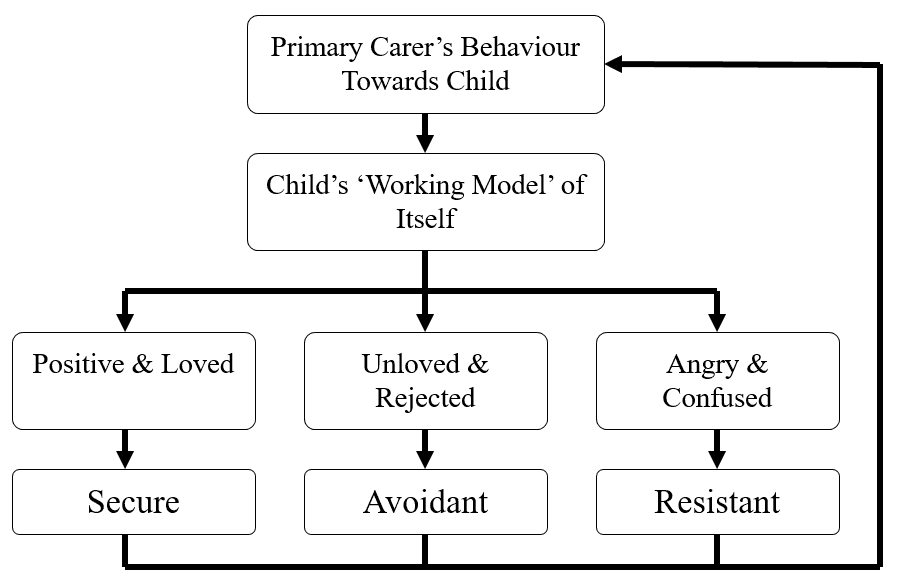

Theoretical Evaluation
caregiver sensitivity theory
This caregiver sensitivity theory is supported by research from Wolff and Van Ijzendoorn (1997), who conducted a meta-analysis (a review) of research into attachment types.
They found that there is a relatively weak correlation of 0.24 between parental sensitivity and attachment type – generally more sensitive parents had securely attached children.
However, in evaluation, critics of this theory argue that the correlation between parental sensitivity and the child’s attachment type is only weak.
This suggests that there are other reasons which may better explain why children develop different attachment types and that the maternal sensitivity theory places too much emphasis on the mother.
Focusing just on maternal sensitivity when explaining why children have different attachment types is, therefore, a reductionist approach.
temperament
An alternative theory proposed by Kagan (1984) suggests that the temperament of the child is actually what leads to the different attachment types. Children with different innate (inborn) temperaments will have different attachment types.
This theory is supported by research from Fox (1989), who found that babies with an ‘Easy’ temperament (those who eat and sleep regularly and accept new experiences) are likely to develop secure attachments.
Babies with a ‘slow to warm up’ temperament (those who took a while to get used to new experiences) are likely to have insecure-avoidant attachments. Babies with a ‘Difficult’ temperament (those who eat and sleep irregularly and who reject new experiences) are likely to have insecure-ambivalent attachments.
In conclusion, the most complete explanation of why children develop different attachment types would be an interactionist theory. This would argue that a child’s attachment type is a result of a combination of factors – both the child’s innate temperament and their parent’s sensitivity towards their needs.
interactionist theory
Belsky and Rovine (1987) propose an interactionist theory to explain the different attachment types. They argue that the child’s attachment type is a result of both the child’s innate temperament and also how the parent responds to them (i.e., the parents’ sensitivity level).
Additionally, the child’s innate temperament may, in fact, influence the way their parent responds to them (i.e, the infants’ temperament influences the parental sensitivity shown to them). To develop a secure attachment, a ‘difficult’ child would need a caregiver who is sensitive and patient for a secure attachment to develop.
Meta-analysis
Madigan et al. (2023) conducted a comprehensive meta-analysis on 285 studies involving over 20,000 infant-caregiver pairs to estimate the global distribution of attachment classifications derived from the SSP: secure (51.6%), avoidant (14.7%), resistant (10.2%), and disorganized (23.5%).
The meta-analysis found no differences in attachment distribution by child age or sex. There was also no difference between mothers and fathers in rates of secure, avoidant, resistant, or disorganized attachment. However, attachment distributions did differ across other moderators.
Higher rates of avoidant and disorganized attachment were found in families with socioeconomic risks. Children who experienced maltreatment had extremely high rates of disorganized attachment (64%) compared to non-maltreated children (22%). Infants placed in foster or adoptive care showed less avoidant attachment but higher disorganized attachment versus biologically related dyads.
A notable finding was a temporal trend showing decreased avoidant attachment over time, perhaps reflecting changes in parenting styles or measurement. Regional differences were also found – Asia, Africa, and South America showed deviations from the North American distribution.
The meta-analysis provides a definitive estimate of the prevalence of secure infant-parent attachment globally (51.6%), supporting the notion that secure attachment is likely to occur when stressors and risks imposed on the parent-infant relationship are minimal.
However, more research is needed on cultural differences in attachment and validity of the SSP across diverse groups. The study also highlights factors like socioeconomic disadvantage and trauma that disrupt secure attachment formation.
Methodological Evaluation
reliability
The strange situation classification has been found to have good reliability. This means that it achieves consistent results. For example, a study conducted in Germany found that 78% of the children were classified in the same way at ages 1 and 6 years (Wartner et al., 1994).
validity
Although, as Melhuish (1993) suggests, the Strange Situation is the most widely used method for assessing infant attachment to a caregiver, Lamb et al. (1985) have criticized it for being highly artificial and lacking ecological validity.
The child is placed in a strange and artificial environment, and the procedure of the mother and stranger entering and leaving the room follows a predetermined script of eight stages (e.g., mum and stranger entering and leaving the room at set times) that would be unlikely to happen in real life.
I have been quite disappointed that so many attachment researchers have gone on to do research with the Strange Situation rather than looking at what happens at the home or in other natural settings—like I said before, it marks a turning away from “field work,” and I don’t think it’s wise. (Ainsworth & Marvin, 1995, p. 12).
The artificial environment of the SSP may not activate the attachment system for all infants, meaning some children could be misclassified (Ziv & Hotam, 2015). For example, avoidant infants may not actually feel stressed when separated from caregivers in this unfamiliar setting. Limited evidence exists linking avoidant behavior in the SSP to physical markers of stress.
Additionally, SSP classifications show only modest connections to expected correlates like maternal sensitivity.
A problem of the study is that it lacks population validity. The original study used American infants from middle-class families.
The study tells us about how this particular group behaves and cannot be generalized to the broader population and other cultures, which might behave differently towards their children and have different expectations.
For example, in Germany, parents encourage independence in their children, so they are less likely to show enthusiastic reunion behavior than children from other cultures.
Mary Ainsworth concluded that the strange situation could be used to identify the child’s type of attachment but has been criticized because it identifies only the type of attachment to the mother.
The child may have a different type of attachment to the father or grandmother, for example (Lamb, 1977). This means that it lacks validity, as it does not measure a general attachment style, but instead an attachment style specific to the mother.
In addition, some research has shown that the same child may show different attachment behaviors on different occasions.
Children’s attachments may change, perhaps because of changes in the child’s circumstances, so a securely attached child may appear insecurely attached if the mother becomes ill or the family circumstances change.
ethics
The strange situation has also been criticized on ethical grounds. Because the child is put under stress (separation and stranger anxiety), the study has broken the ethical guidelines for the protection of participants.
However, in its defense, the separation episodes were curtailed prematurely if the child became too stressed.
Also, according to Marrone (1998), although the Strange Situation has been criticized for being stressful, it simulates everyday experiences, as mothers leave their babies for brief periods in different settings and often with unfamiliar people such as babysitters.
categorial measurement
The categorical approach to classification may be too reductive to fully capture the complexity of infant attachment patterns (Ziv & Hotam, 2015).
Reducing attachment security to four rigid categories treats the SSP as a “weigh scale” reflecting a “true score” when attachment is likely more continuous and multidimensional.
This oversimplification could hamper the refinement of attachment theory if inconsistencies are attributed to limitations of the theory rather than the measure.
Infant attachment is complex, with individual differences likely being continuous rather than falling neatly into discrete categories.
Frequently Asked Questions
What are Mary Ainsworth’s contributions to psychology
Mary Ainsworth significantly contributed to psychology by developing the ‘Strange Situation’ procedure to observe attachment relationships between a caregiver and child. Her work shaped our understanding of attachment styles: secure, avoidant, and ambivalent, greatly influencing developmental and child psychology.
How is the Strange Situation important?
The Strange Situation experiment is important because it was a breakthrough in identifying different attachment styles in infants.
Ainsworth’s research showed that how caregivers respond to a child’s needs can have a lasting impact on their emotional development. The experiment provided a reliable way to measure attachment styles, which has helped researchers and clinicians better understand how attachment influences a person’s relationships throughout their life.
Ainsworth’s work has also influenced how parents and caregivers understand the importance of emotional responsiveness and sensitive care in promoting secure attachment and healthy child development.
Can a child’s attachment style change over time?
Yes, a child’s attachment style can change over time. While attachment styles tend to be stable, experiences with caregivers and changes in the child’s environment can lead to shifts in attachment style.
For example, a child with an insecure attachment style may become more secure with consistent and responsive caregiving. Conversely, a child with a secure attachment style may develop an insecure attachment style due to neglect, abuse, or other adverse experiences.
Is Ainsworth research ethnocentric?
Ethnocentrism is when someone thinks their own cultural or ethnic group is the most important, and they judge other cultures or ethnic groups based on their own standards and values. They may see other groups as inferior or less important.
Some researchers argue that Mary Ainsworth’s Strange Situation experiment is ethnocentric because it was originally conducted on a relatively small sample of middle-class American families.
Critics argue that the experiment may not represent attachment patterns in other cultures and may not account for cultural differences in child-rearing practices.
What is the difference between secure and insecure attachment?
Secure and insecure attachments are broad classifications that describe how we think, feel, and behave in relationships.
Secure attachment in adults is characterized by trust, stability, and a balance between intimacy and independence. Insecure attachment (anxious, avoidant, or disorganized) can involve fear of abandonment, emotional distance, or inconsistent reactions to intimacy and conflict.
References
Ainsworth, M. D. (1964). Patterns of attachment behavior shown by the infant in interaction with his mother. Merrill-Palmer Quarterly of behavior and Development, 51-58.
Ainsworth, M. D. S. (1967). Infancy in Uganda: Infant care and the growth of love.
Ainsworth, M. D. S. (1979). Attachment as related to mother-infant interaction. In Advances in the study of behavior (Vol. 9, pp. 1-51). Academic Press.
Ainsworth, M. D. S., & Bell, S. M. (1970). Attachment, exploration, and separation: Illustrated by the behavior of one-year-olds in a strange situation. Child Development, 41, 49-67.
Ainsworth, M. D. S., Bell, S. M., & Stayton, D. J. (1971) Individual differences in strange- situation behavior of one-year-olds. In H. R. Schaffer (Ed.) The origins of human social relations. London and New York: Academic Press. Pp. 17-58.
Ainsworth, M. D. S., Blehar, M. C., Waters, E., & Wall, S. (1978). Patterns of attachment: A psychological study of the strange situation. Hillsdale, NJ: Erlbaum.
Ainsworth, M., & Marvin, R. (1995). On the shaping of attachment theory and research: An interview with Mary D. S. Ainsworth. Monographs of the Society for Research in Child Development, 60(Serial No. 244), 3–24.
Ainsworth, M. D. S., & Wittig, B. A. (1969). Attachment and exploratory behavior of one-year-olds in a strange situation. In B. M. Foss(Ed. ), Determinants of infant behavior (Vol. 4,pp. 111-136). London: Methuen.
Behrens, K. Y., Hesse, E., & Main, M. (2007). Mothers” attachment status as determined by the Adult Attachment Interview predicts their 6-year-olds” reunion responses: A study conducted in Japan. Developmental Psychology, 43(6), 1553.
Belsky, J., & Rovine, M. (1987). Temperament and attachment security in the strange situation: An empirical rapprochement. Child development, 787-795.
Bowlby, J. (1969). Attachment. Attachment and loss: Vol. 1. Loss . New York: Basic Books.
Bowlby, J. (1980). Loss: Sadness & depression. Attachment and loss (vol. 3); (International psycho-analytical library no.109). London: Hogarth Press.
Fox, N. A. (1989). Infant temperament and security of attachment: a new look. International Society for behavioral Development, J yviiskylii, Finland.
Jacobsen, T., & Hoffman, V. (1997). Children’s attachment representations: Longitudinal relations to school behavior and academic competency in middle childhood and adolescence. Developmental Psychology, 33, 703-710.
Kagan, J., Reznick, J. S., Clarke, C., Snidman, N., & Garcia-Coll, C. (1984). behavioral inhibition to the unfamiliar. Child development, 2212-2225.
Kobak, R. R., Cole, H. E., Ferenz-Gillies, R., Flemming, W. S., & Gamble, W. (1993). Attachment and emotional regulation during mother-teen problem-solving. A control theory analysis. Child Development, 64, 231-245.
Lamb, M. E. (1977). The development of mother-infant and father-infant attachments in the second year of life. Developmental Psychology, 13, 637-48.
Larose, S., & Bernier, A. (2001). Social support processes: Mediators of attachment state of mind and adjustment in later late adolescence. Attachment and Human Development, 3, 96-120.
Madigan, S., Fearon, R. M. P., van IJzendoorn, M. H., Duschinsky, R., Schuengel, C., Bakermans-Kranenburg, M. J., Ly, A., Cooke, J. E., Deneault, A.-A., Oosterman, M., & Verhage, M. L. (2023). The first 20,000 strange situation procedures: A meta-analytic review. Psychological Bulletin, 149(1-2), 99–132.
Main, M., & Solomon, J. (1990). Procedures for identifying infants as disorganized/disoriented during the Ainsworth Strange Situation. In M.T. Greenberg, D. Cicchetti & E.M. Cummings (Eds.), Attachment in the Preschool Years (pp. 121–160). Chicago, University of Chicago Press.
Marrone, M. (1998). Attachment and interaction . Jessica Kingsley Publishers.
Melhuish, E. C. (1993). A measure of love? An overview of the assessment of attachment. ACPP Review & Newsletter, 15, 269-275.
Stayton, D. J., & Ainsworth, M. D. (1973). Individual differences in infant responses to brief, everyday separations as related to other infant and maternal behaviors. Developmental Psychology, 9(2), 226.
Schaffer, H. R., & Emerson, P. E. (1964) The development of social attachments in infancy. Monographs of the Society for Research in Child Development, 29(3), serial number 94.
Stevenson-Hinde, J., & Verschueren, K. (2002). Attachment in childhood. status: published .
Thompson, R. A., Gardner, W., & Charnov, E. L. (1985). Infant-mother attachment: The origins and developmental significance of individual differences in Strange Situation behavior. LEA.
Wartner, U. G., Grossman, K., Fremmer-Bombik, I., & Guess, G. L. (1994). Attachment patterns in south Germany. Child Development, 65, 1014-27.
Wolff, M. S., & Ijzendoorn, M. H. (1997). Sensitivity and attachment: A meta‐analysis on parental antecedents of infant attachment . Child development, 68(4), 571-591.
Ziv, Y., & Hotam, Y. (2015). Theory and measure in the psychological field: The case of attachment theory and the strange situation procedure. Theory & Psychology, 25(3), 274-291.
Further Reading
- BPS Article- Overrated: The predictive power of attachment
- The Ainsworth Strange Situation (Lecture Slides)
- Scoring for the Strange Situation
- A theoretical review of the infant-mother relationship
- Cross-cultural Patterns of Attachment: A Meta-Analysis of the Strange Situation

